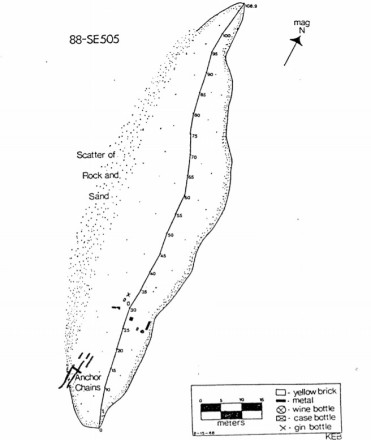History
Background
A number of shipwrecks have been identified in the Oranje Bay of Sint Eustatius which have been given names starting with SE.
SE-505, located approximately 60 meters to the west of SE-504, is part of the 'Triple Wreck' dive site. The site is 109 meters long and 25 meters wide, and oriented in a north-south direction along its main axis. The site is located on a sandy sea floor at a depth of 20 meters and consists of a ballast pile of which the entire western side is a ballast scatter. It is believed that this resulted from the vessel’s side spilling open as the ship decomposed. The piles of ballast stones are completely overgrown with a variety of sponges and corals and inhabited by large numbers of fish and invertebrates. Most wood has been completely destroyed by shipworm (Teredo navalis), a species of saltwater clam that is notorious for burrowing through submerged wood. The site’s northern and southern ends, and the entire eastern side, rise approximately 1 meter from the sea floor. The southern part of the site contains a double set of anchor chains and a metal object that may be associated with an anchor.

Description
Status
No excavations have been conducted on this site and the limited research performed in 1987 and 1988 by East Carolina University did not produce sufficient information necessary to support any conclusions about this vessel regarding its age, origin, or nature (Bequette 1992, p. 138).
References
- Kathryn Bequette (1992).
An Archaeological Reconnaissance of the Anchorage, Seawalls, and Shipwrecks within Oranje Bay, St. Eustatius, Netherlands Antilles.
East Carolina University. - Ruud Stelten (2019).
From Golden Rock to Historic Gem: A Historical Archaeological Analysis of the Maritime Cultural Landscape of St. Eustatius Dutch Caribbean.
Leiden: Sidestone Press.